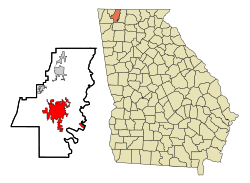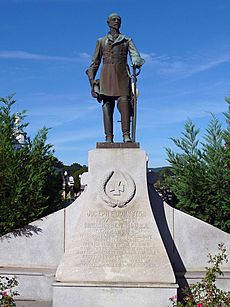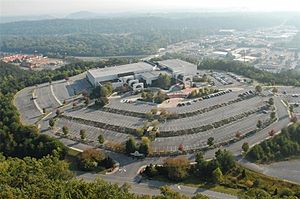Dalton, Georgia facts for kids
Quick facts for kids
Dalton, Georgia
|
|
|---|---|
| City of Dalton | |

Downtown Dalton
|
|
| Nickname(s):
Carpet Capital of the World
|
|

Location in Whitfield County and the state of Georgia
|
|
| Country | United States |
| State | Georgia |
| County | Whitfield |
| Area | |
| • City | 21.16 sq mi (54.80 km2) |
| • Land | 21.14 sq mi (54.76 km2) |
| • Water | 0.02 sq mi (0.04 km2) |
| Elevation | 761 ft (232 m) |
| Population
(2020)
|
|
| • City | 34,417 |
| • Density | 1,627.90/sq mi (628.52/km2) |
| • Urban | 102,599 |
| • Metro | 142,227 |
| Time zone | UTC-5 (Eastern (EST)) |
| • Summer (DST) | UTC-4 (EDT) |
| ZIP codes |
30719-30722
|
| Area code(s) | 706/762 |
| FIPS code | 13-21380 |
| GNIS feature ID | 0355424 |
| Website | http://www.cityofdalton-ga.gov/ |
Dalton is a city and the county seat of Whitfield County, Georgia, United States. It is also the principal city of the Dalton Metropolitan Statistical Area, which encompasses all of Murray and Whitfield counties.
As of the 2010 census, the city had a population of 33,128 people, with the total metropolitan area having a population of 142,227. Dalton is located just off Interstate 75 in the foothills of the Blue Ridge Mountains in northwest Georgia and is the second-largest city in northwest Georgia, after Rome.
Dalton is home to many of the nation's floor-covering manufacturers, primarily those producing carpet, rugs, and vinyl flooring. It is home to the Dalton Convention Center, which showcases the Georgia Athletic Coaches' Hall of Fame and hosts a variety of events.
Contents
Geography
Dalton is located at (34.771088, -84.971553). According to the United States Census Bureau, the city has a total area of 19.8 square miles (51 km2), of which 19.8 square miles (51 km2) is land and 0.04 square miles (0.10 km2) (0.10%) is water.
Demographics
| Historical population | |||
|---|---|---|---|
| Census | Pop. | %± | |
| 1860 | 1,649 | — | |
| 1870 | 1,809 | 9.7% | |
| 1880 | 2,516 | 39.1% | |
| 1890 | 3,046 | 21.1% | |
| 1900 | 4,315 | 41.7% | |
| 1910 | 5,324 | 23.4% | |
| 1920 | 5,222 | −1.9% | |
| 1930 | 8,160 | 56.3% | |
| 1940 | 10,448 | 28.0% | |
| 1950 | 15,968 | 52.8% | |
| 1960 | 17,868 | 11.9% | |
| 1970 | 18,872 | 5.6% | |
| 1980 | 20,939 | 11.0% | |
| 1990 | 21,761 | 3.9% | |
| 2000 | 27,912 | 28.3% | |
| 2010 | 33,128 | 18.7% | |
| 2020 | 34,417 | 3.9% | |
| U.S. Decennial Census | |||
2020 census
| Race | Num. | Perc. |
|---|---|---|
| White (non-Hispanic) | 12,027 | 34.94% |
| Black or African American (non-Hispanic) | 2,108 | 6.12% |
| Native American | 48 | 0.14% |
| Asian | 859 | 2.5% |
| Pacific Islander | 7 | 0.02% |
| Other/Mixed | 866 | 2.52% |
| Hispanic or Latino | 18,502 | 53.76% |
As of the 2020 United States census, there were 34,417 people, 11,305 households, and 7,470 families residing in the city.
2010 census
According to the 2010 census Dalton had a population of 33,128 living in 11,337 households. The racial and ethnic composition of the population was 42.4% non-Hispanic white, 22.6% Hispanic, 6.4% black, 0.6% Native American, 2.4% Asian, 0.1% Pacific Islander, 0.1% non-Hispanic reporting some other race, 22.2% Hispanic reporting some other race and 3.2% reporting two or more races. 48.0% of the population was Hispanic or Latino.
Election Results
| Year | Democratic | Republican | Others |
|---|---|---|---|
| 2020 | 44.46% 3,976 | 54.12% 4,839 | 1.42% 127 |
| 2016 | 40.26% 3,015 | 55.99% 4,193 | 3.75% 281 |
| 2012 | 37.01% 2,504 | 61.93% 4,190 | 1.06% 72 |
Mexican Americans
In the 1990s, Mexicans began to immigrate to Dalton to work at carpet factories. By 2010, 48% of Dalton's 33,000 residents were Latino, comprising a plurality of all residents. During the late 1980s economic boom – when demand for carpet mill laborers reached an all-time high – the 320 carpet mills aggressively recruited Latino workers. As of 2012, Hispanics constituted the plurality of students at Dalton High School.
Climate
Dalton has a humid subtropical climate (Cfa), with hot, humid summers, and mild to cool winters, and straddles the border between USDA Hardiness Zones 7B and 8A. The monthly daily mean temperature ranges from 40.1 °F (4.5 °C) in January to 79.0 °F (26.1 °C) in July; on average, there are 41 days of 90 °F (32 °C)+ highs, 2.7 days where the high fails to reach above freezing, and 10.7 nights where the low falls to or below 20 °F (−7 °C) annually, with 100 °F (38 °C) a much rarer occurrence.
| Climate data for Dalton, Georgia (1981–2010 normals) | |||||||||||||
|---|---|---|---|---|---|---|---|---|---|---|---|---|---|
| Month | Jan | Feb | Mar | Apr | May | Jun | Jul | Aug | Sep | Oct | Nov | Dec | Year |
| Average high °F (°C) | 50.1 (10.1) |
54.8 (12.7) |
64.0 (17.8) |
72.1 (22.3) |
79.6 (26.4) |
86.2 (30.1) |
89.6 (32.0) |
89.2 (31.8) |
83.4 (28.6) |
74.0 (23.3) |
63.1 (17.3) |
52.7 (11.5) |
71.6 (22.0) |
| Average low °F (°C) | 30.1 (−1.1) |
32.6 (0.3) |
39.5 (4.2) |
45.7 (7.6) |
55.5 (13.1) |
63.9 (17.7) |
68.3 (20.2) |
67.6 (19.8) |
60.9 (16.1) |
49.1 (9.5) |
39.7 (4.3) |
33.0 (0.6) |
48.9 (9.4) |
| Average precipitation inches (mm) | 5.18 (132) |
4.90 (124) |
4.99 (127) |
4.04 (103) |
4.12 (105) |
4.68 (119) |
5.23 (133) |
4.00 (102) |
4.89 (124) |
3.52 (89) |
4.93 (125) |
4.85 (123) |
55.33 (1,406) |
| Average precipitation days (≥ 0.01 in) | 8.7 | 8.6 | 9.3 | 8.2 | 8.3 | 9.7 | 9.8 | 8.1 | 7.1 | 6.3 | 8.6 | 8.5 | 101.2 |
Arts and culture
- Creative Arts Guild
The Creative Arts Guild is the oldest multi-disciplinary community arts center in the state of Georgia. Founded in 1963 by a group of civic leaders, the Creative Arts Guild began as a community grass-roots movement originally housed in the Old Firehouse on Pentz Street in historic Downtown Dalton. The Guild began offering art, music, dance and theatre classes as well as gallery shows and exhibitions. As programming and class attendance grew, plans for a larger facility were developed. In 1981, the Guild moved to its permanent home at 520 West Waugh Street. The vision of that small group of patrons has grown into an organization that now houses four educational departments (visual art, dance, gymnastics, and music) as well as the Arts in Education outreach programs, events, gallery exhibits, music and dance concerts and recitals and acts as a hub of culture for North West Georgia and South East Tennessee.
- Artistic Civic Theatre
Artistic Civic Theatre has served the Northwest Georgia community for twenty-four years, and has reached thousands of citizens through major musical, comedy, and drama productions, ACT2 (the children's wing), student productions in cooperation with schools in Dalton, Whitfield, and Murray counties, touring productions of original adaptations of classic fairy tales, theatrical arts classes co-sponsored with the Creative Arts Guild, the annual Youth Theatre Camp, and the Studio Cabaret live music series. ACT's programs are funded through individual and family memberships, as well as corporate sponsorships and donations. Consider becoming a member or corporate sponsor and help us continue to provide theatrical arts opportunities, entertainment, and educational programs to the Northwest Georgia Community.
- Dalton Little Theatre
Dalton Little Theatre held its first documented performance in 1869. The organization began as the Dalton Amateurs, and continued as the Sophoclean Dramatic Club, and the Dalton Players, before becoming Dalton Little Theatre in 1955. The theatre has performed continuously except for breaks during World War I and World War II. The organization formally incorporated in 1958, and found its first home in 1981 when it converted the former firehouse built in 1888 into the Firehouse Theatre. The Firehouse Theatre is often referred to as the Old Dalton Firehouse and it remains the home of Dalton Little Theatre to this day.
- 1000 Words Dalton Public Art Project
1000 Words is a grassroots effort to encourage community identity through creating a sense of place; cultural value - through bringing groups together to create art that defines our community and creates a sense of attachment; economic growth through the acknowledgement that beauty and inspiration attract people; and accessibility of art through creating public art that is free for all.
- Other Events
The Downtown Dalton Development Authority hosts a number of events throughout the year, including the Downtown Dalton Farmers Market (May–August), a Downtown Sampler, and an annual Beer Festival. The Dalton Area Convention & Visitors Bureau partners with the DDDA to host the Downtown Dalton Summer Concert Series, featuring local bands. The Young Professionals of Northwest Georgia host a monthly social event to connect and engage area young professionals
History
Woodland Indians and Creek Nation held the area of present-day Dalton, Georgia until the mid-18th century, when the Cherokee pushed the Creek to the west and south. The Cherokee Indians called the mountains of north Georgia their "Enchanted Land" until their forced removal in 1838, in a tragedy known today as the Trail of Tears.
By the time the last Cherokees had left, work was underway for a railroad, the Western and Atlantic (W&A), to join the Tennessee River with the Georgia Railroad then under construction. In 1847, Dalton was defined as a mile radius from the city center, the Western and Atlantic Depot. The final segment of this pivotal railway was completed in Tunnel Hill, Whitfield County in 1850. A second railroad, the East Tennessee and Georgia, was completed in 1852.
Catherine Evans Whitener's revitalization of the pre-Civil War-era craft of candlewicking gave rise to a cottage chenille bedspread industry. Homes along U.S. Highway 41 displayed brightly patterned homemade bedspreads on frontyard clotheslines in hopes of luring tourists into a purchase. The stretch of highway passing through Whitfield County became known colloquially as "Peacock Alley" in reference to one of the most common patterns depicted on the bedspreads. The bedspread business booned to a multimillion-dollar industry by the 1950s, and from this early origin, the carpet tufting industry grew in Dalton after Glenn Looper developed an adaptation that allowed the mechanism used to tuft yarn into muslin or cotton for bedspreads to tuft into jute, shifting the nation's carpet manufacturers from woven wool products in the northeast to tufted synthetic carpets in northwest Georgia. Today, carpet mills remain the region's major employers and economic drivers.
Dalton, was named for General Tristram Dalton of Massachusetts.
Civil War

During the Civil War, Dalton saw its first action during the Great Locomotive Chase, on April 12, 1862.
More than a year later, on September 19–20, 1863, massive Union and Confederate forces battled a few miles west of Dalton at Chickamauga, and later at Chattanooga. The war came to Whitfield County in the spring of 1864. The First Battle of Dalton included the battle of Rocky Face Ridge and Dug Gap began on May 7, 1864, and ended when General Johnston completed his withdrawal from Dalton on May 12.
The Second Battle of Dalton occurred August 14–15, 1864.
In John Bell Hood's Tennessee campaign, Joseph Wheeler's cavalry attacked a Union blockhouse in Tilton before passing through Dalton and heading west.
The U.S. government recently declared Dalton and Whitfield County to have more intact Civil War artifacts than any other place in the country. Also of interest is the site of the historic Western & Atlantic Railroad Station; one of the few still standing and restored to its original architectural state, this site is now the Dalton Depot Restaurant. The steel center marker for the original surveying of the city of Dalton is still inside the depot.
Carpet industry
Dalton is often referred to as the "Carpet Capital of the World," home to 150+ carpet plants. The industry employs more than 30,000 people in the Whitfield County area. More than 90% of the functional carpet produced in the world today is made within a 65-mile (105 km) radius of the city.
The agglomeration of the carpet industry in Dalton can be traced back to a wedding gift given in 1895 by a teenage girl, Catherine Evans Whitener, to her brother, Henry Alexander Evans, and his bride, Elizabeth Cramer. The gift was an unusual tufted bedspread. Copying a quilt pattern, she sewed thick cotton yarns with a running stitch into unbleached muslin, clipped the ends of the yarn so they would fluff out, and finally, washed the spread in hot water to hold the yarns by shrinking the fabric. Interest grew in young Catherine's bedspreads, and in 1900, she made the first sale of a spread for $2.50. Demand for the spreads became so great that by the 1930s, local women had "haulers," who would take the stamped sheeting and yarns to front porch workers. Often entire families worked to hand-tuft the spreads for 10 to 25 cents per spread. Nearly 10,000 area cottage "tufters," men, women, and children, were involved in the industry. Income generated by the bedspreads was instrumental in helping many area families survive the Depression. Chenille bedspreads became popular all over the country and provided a new name for Dalton: the Bedspread Capital of the World.
When a form of mechanized carpet making was developed after World War II, Dalton became the center of the new industry because specialized tufting skills were required and the city had a ready pool of workers with those skills.
By the 1970s manufacturers had begun to develop techniques to move from plain tufted carpet to sculpted carpet. Improved patterning, stain and wear resistance, and colors have made today's tufted carpet the choice for functional carpet for the vast majority of homes, and moved woven carpet to a decorative role.
Environmental problems
Dalton's carpet production has taken up to one-third of the Conasauga River summer water flow. The river and city water supply has been contaminated with perfluorinated compounds used to make carpets stain-resistant. Dalton Utilities' has processed wastewater using a land application system, that spread effluent on more than nine thousand forested acres in an area called Looper's Bend. Runoff was found to drip down into the river.
Sister cities
Education
Public schools
The Dalton City School District, which covers the entire city of Dalton, holds pre-school to grade twelve, and consists of six elementary schools, a middle school, a high school, and an alternative school. The district has 366 full-time teachers and over 5,739 students.
- Blue Ridge Elementary School
- Brookwood Elementary School
- City Park Elementary School
- Park Creek Elementary School
- Roan Street Elementary School
- Westwood Elementary School
- Dalton Middle School
- Dalton High School
- Morris Innovative High School
The Whitfield County School District serves areas outside of the Dalton city limits, even if they have "Dalton, GA" postal addresses. Coahulla Creek High School, Phoenix High School, and Southeast Whitfield High School have Dalton postal addresses but lie outside of the city limits and serve areas not in the city limits.
Charter schools
- Whitfield County Career Academy
Alternative schools
- Fort Hill Complex (Crossroads Academy)
Independent schools
- Christian Heritage School
Higher education
- Dalton State College – Main Campus
- Georgia Northwestern Technical College (Whitfield/Murray Campus)
Infrastructure
Air
Dalton Municipal Airport, a general aviation airport, lacking scheduled commercial flights, is southeast of the city. International airports are in Chattanooga to the north and Atlanta to the south.
Rail
The Southern Railway had two Cincinnati to Florida named trains, Ponce de Leon (Cincinnati to Florida via Lexington, Chattanooga and Atlanta) and Royal Palm (Cincinnati to Florida via Lexington, Chattanooga and Atlanta) that made stops in the town into the 1960s. The Louisville and Nashville Railroad's Dixie Flagler (Chicago and St. Louis to Florida), Dixie Flyer (Chicago and St. Louis to Florida) and Georgian (Chicago and St. Louis to Atlanta) also made stops in Dalton. The last train was an unnamed L&N Evansville, Indiana - Atlanta, Georgia remnant of the Georgian, ending service on April 30, 1971.
Roads
Interstate 75 runs a short distance west of the city. The modern U.S. Route 41 and U.S. Route 76 circumvent Dalton, but historically they ran through the city. Georgia State Route 52 runs through the city's downtown.
Notable people
- Morris Almond, professional basketball player
- Mitchell Boggs, former professional baseball player
- Walter Scott Bogle, Author
- Susan Dennard, author of The Witchlands series
- Eddie Dwight, baseball player in the Negro leagues
- Stephen E. Gordy, Virginia politician
- Will N. Harben, Author
- Tammy Jo Kirk, NASCAR driver
- Robert Loveman, poet
- Marla Maples, actress and former wife of Donald Trump (native of nearby Cohutta)
- Harlan Erwin Mitchell, United States representative from Georgia
- Deborah Norville, television anchor and journalist
- Steve Prohm, head men's basketball coach at Iowa State University
- Harry Leon "Suitcase" Simpson, African American major league baseball player
- Dale Singleton, motorcycle racer
- Linda Vaughn, Miss Hurst Shifter
- Lane Davies, American actor
See also
 In Spanish: Dalton (Georgia) para niños
In Spanish: Dalton (Georgia) para niños



